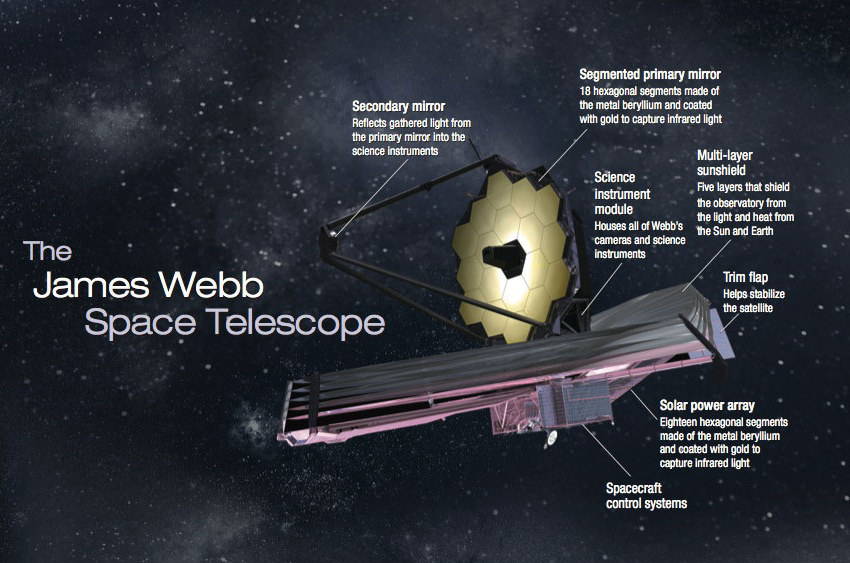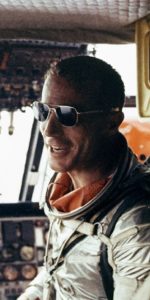
Often referred to as the successor for Hubble, the James Webb Space Telescope (JWST) is one of the most highly anticipated space telescopes ever built. A large infrared telescope with a 6.5-meter primary mirror, JWST will be able to look at every phase of the Universe, from the period just after the Big Bang to the formation of stars, galaxies, exoplanets and even our own Solar System. Scheduled for launch in fall 2018, JWST recently arrived at NASA’s Johnson Space Center in Houston, Texas, where it will undergo its last, and crucial, cryogenic test.
The telescope made a few stops along the way, first being taken from NASA’s Goddard Space Flight Center in Greenbelt, Maryland by trailer truck, then being driven very slowly (as always with such loads) to Joint Base Andrews in Maryland. There, the entire assemblage, including the tractor-trailer, was loaded onto a U.S. Air Force C-5C aircraft and flown to Ellington Field in Houston, Texas. After landing at Ellington, the telescope was transported by truck to Johnson Space Center, where the telescope was finally removed from its protective shipping container inside the cleanroom.
The upcoming cryogenic test will run for nearly 100 days. These tests are designed to ensure the telescope can function properly in the extreme cold of space, 1 million miles from Earth. The tests are carried out in a vacuum; the largest and final test will be conducted in Johnson’s Chamber A, the same vacuum chamber where the Apollo spacecraft were tested. This test will help engineers ensure that the entire telescope operates properly.

The final assembly and testing for JWST will later take place at Northrop Grumman Aerospace Systems in Redondo Beach, California.
Prior to this, the telescope recently underwent rigorous environmental testing at Goddard. These tests simulated the stresses of launch, which JWST passed with flying colors.
“The Webb telescope is about to embark on its next step in reaching the stars as it has successfully completed its integration and testing at Goddard. It has taken a tremendous team of talented individuals to get to this point from all across NASA, our industry and international partners, and academia,” said Bill Ochs, NASA’s Webb telescope project manager. “It is also a sad time as we say goodbye to the Webb Telescope at Goddard, but are excited to begin cryogenic testing at Johnson.”
High levels of vibration and noise are created by the rocket during launch which can rattle the rocket and any cargo on board. Optical engineers set up an interferometer, before and after the tests, which measures the shape of the telescope’s mirror with high precision. The optics on the telescope must be shaped and aligned extremely accurately, even better than a thousandth of a millimeter long, which is the length of a wave of visible light. These measurements also help to prevent physical damage, such as scratches, to the mirror. Even in the cleanroom, however, tiny vibrations are always present. To account for this, the interferometer is a “high-speed” one, taking 5,000 “frames” every second, which is a faster rate than the background vibrations themselves. This allows engineers to subtract out jitter and get good, clean results on any changes to the mirror’s shape.
According to Ritva Keski-Kuha, the test lead and NASA’s Deputy Telescope Manager for JWST at NASA’s Goddard Space Flight Center in Greenbelt, Md., “This is the only test of the entire mirror where we can use the same equipment during a before and after test. This test will show if there are any changes or damages to the optical system.”
“Some people thought it would not be possible to measure beryllium mirrors of this size and complexity in a clean room to these levels but the team was incredibly ingenious in how they performed these measurements and the results give us great confidence we have a fantastic primary mirror,” said Lee Feinberg, the telescope’s optical element manager.
Last month, JWST “bloomed,” with its bright primary mirror unfolded like a spring flower. The 18 segments of the mirror are designed to capture infrared light from the first galaxies that formed in the early Universe; with these, the telescope can also peer inside dust clouds where stars and planetary systems are forming today.

With an impressive array of instruments, JWST will be the most powerful space telescope built to date. Named after a former NASA administrator, James Webb, JWST will look at distant exoplanets and the dust clouds where new stars and planets are being born, as well as search for the molecular building blocks of life. It will also be able to directly image some larger exoplanets orbiting brighter stars by using coronagraphs, and it will also be able to study the atmospheres of those exoplanets, which will be another significant step in the search for extraterrestrial life. Not an easy task, but JWST will be well-equipped to do just that. Previously, before 2002, JWST was known as the “Next Generation Space Telescope” (NGST).
“The James Webb Space Telescope will be the premier astronomical observatory of the next decade,” said John Grunsfeld, astronaut and associate administrator of the Science Mission Directorate at NASA Headquarters in Washington. “This first-mirror installation milestone symbolizes all the new and specialized technology that was developed to enable the observatory to study the first stars and galaxies, examine the formation stellar systems and planetary formation, provide answers to the evolution of our own Solar System, and make the next big steps in the search for life beyond Earth on exoplanets.”
There are four main themes for the JWST mission: First Light & Reionization, Assembly of Galaxies, Birth of Stars & Planetary Systems and Planets & Origins of Life.
“The James Webb Space Telescope will be a giant leap forward in our quest to understand the Universe and our origins. JWST will examine every phase of cosmic history: from the first luminous glows after the Big Bang to the formation of galaxies, stars, and planets to the evolution of our own Solar System.”



The telescope’s stunning array of golden mirrors have even made it the feature of an art exhibition. Twenty-five applicants were selected to visit Goddard in November 2016, and the resulting creations are now on display at the NASA Goddard Visitor Center.
“The first time NASA Goddard got to see the ‘face’ of Webb – those beautiful, giant, golden mirrors – was magical,” said Maggie Masetti, the project’s social media lead and website manager at NASA’s Goddard Space Flight Center in Greenbelt, Maryland. “Getting to see one’s self reflected in something that will see the first stars and galaxies is a humbling experience, and one that makes you think about how humanity is tied in with the things we are exploring.”
“Popular art can elevate the profile of real scientific discoveries in a practical way,” said comic artist Veronica Guzzardi. “My job is to be a cheerleader for all the wonderousness of the universe. To help everyone understand, in the unique ways we are able, is the job of every artist and scientist.”
JWST will be launched on an Ariane 5 rocket from French Guiana in October of 2018. It is indeed a worthy successor to the Hubble Space Telescope, and will show the very early Universe, and current galactic neighborhood, as never before.
The James Webb Space Telescope is a joint project of NASA, the European Space Agency and the Canadian Space Agency. More information about JWST is available here or here.
Be sure to “LIKE” AmericaSpace on Facebook and follow us on Instagram & Twitter!
.
Missions » James Webb Telescope »





“There are four main themes for the JWST mission: First Light & Reionization, Assembly of Galaxies, Birth of Stars & Planetary Systems and Planets & Origins of Life”
Does this space based telescope create the possibility of finding extraterrestrial life in no uncertain terms?…If so what does this mean for the fragile political state of Earth? Is this uncertain potential the reason for the launch delay all of these years under the guise of “manufacturing difficulties” ? Could President Trump be the last President of the United States as such a finding would create the emphasis for the creation if a one world government structure complete with new global constitution?